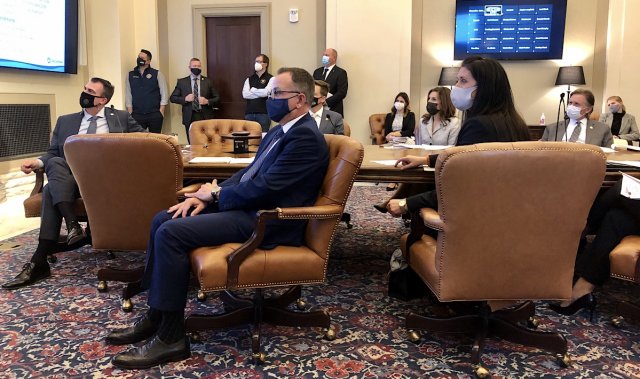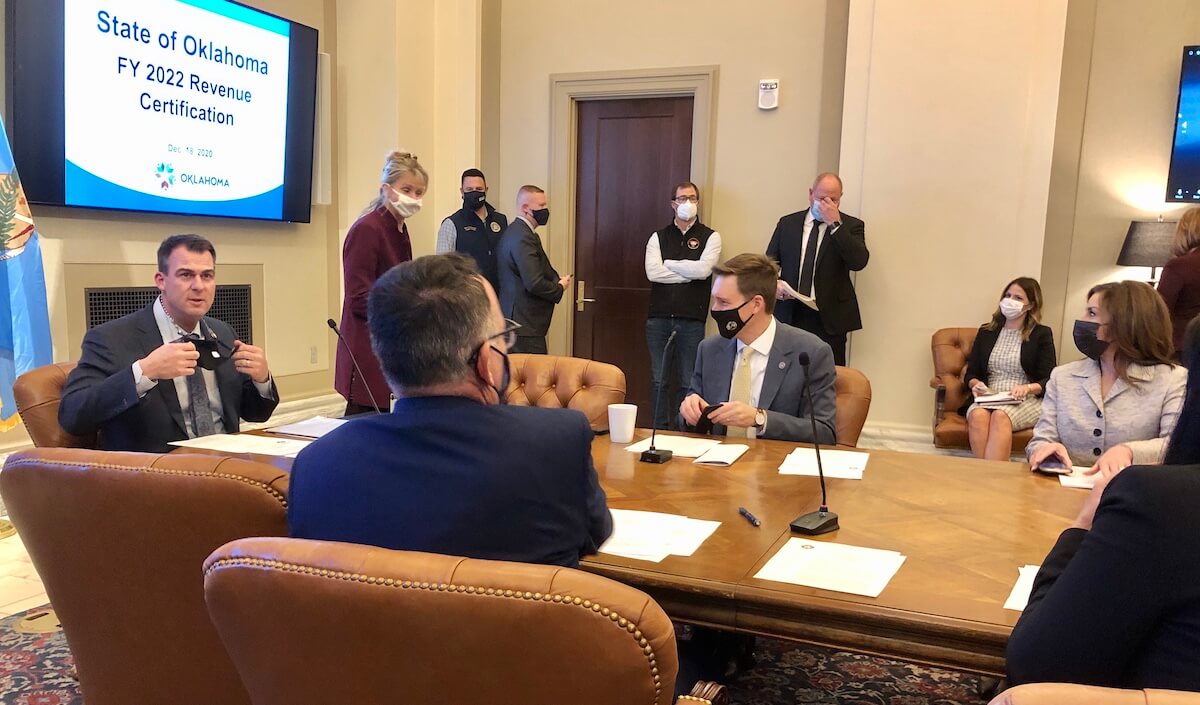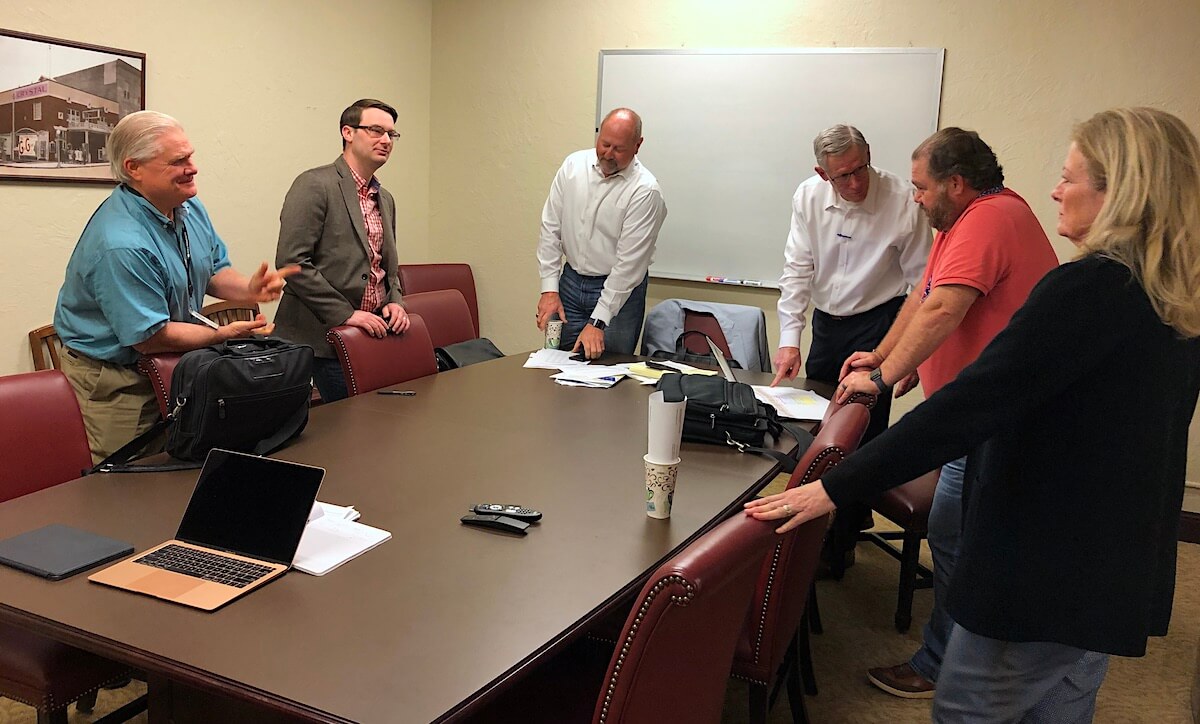

While House Appropriations and Budget Chairman Kevin Wallace stood against a wall during today’s Oklahoma Board of Equalization hearing, he fidgeted as statewide elected officials pondered whether an unexpected cash reserve meant the Legislature could consider hiking agency appropriations for the final six months of Fiscal Year 2021.
Eventually, Wallace addressed Gov. Kevin Stitt.
“I know I’m not a member of the board,” Wallace said cautiously. “But there was a creative and innovative budget put in place last year based on the uncertainty we were dealing with.”
What Wallace meant — and what the state’s top financial bureaucrats hope Oklahoma’s political chattering class remembers when the Legislature convenes Feb. 1 — was that the state budget passed in May avoided catastrophic cuts by using almost $1 billion in non-recurring revenues.
As a result, even if today’s estimate of almost $600 million more being available for FY 2022 holds when the board gives the Legislature its final expenditure authorization in February, the year’s budget will still pose challenges.
“That is a good point,” Stitt told Wallace (R-Wellston). “Thanks for that comment.”
Wallace replied: “I don’t want to be out of line.”
Attorney General Mike Hunter, a member of the constitutional board, injected levity into the moment.
“Don’t let it happen again,” he said to laughter.
Remember last year’s state budget battle?

When Stitt, the rest of the board, Oklahoma Tax Commission director Jay Doyle and media were in the same room for an April meeting of the Board of Equalization, there had been no laughter.
At the time, the Stitt administration and legislative leaders were at odds over how a FY 2020 revenue shortfall should have been addressed and how lawmakers should approach the FY 2021 budget with crashed petroleum prices and enormous economic uncertainty in the face of a pandemic.
The Board of Equalization ultimately approved a letter from Stitt to lawmakers encouraging them to reduce appropriations significantly out of caution for an economic crash. Legislators pushed back, saying their fiscal staff’s projections were less severe and that state agencies could not sustain cuts in the range of 10 to 16 percent.
The disagreement over how best to craft the FY 2021 state budget turned into a game of political chicken, with legislators using an almost unprecedented amount of one-time sources to limit cuts to 4 percent (and closer to 2 percent for common education). Stitt responded by vetoing the budget and watched as lawmakers giddily overrode his decision and spent more than an hour trashing his statements in pointed floor speeches.
‘A much different dialogue’ expected next year

Next year, Wallace is “very optimistic” that legislative leaders and the governor will avoid the acrimony of the last session’s budget dispute.
“We are in communications, and after last session I had many meetings with the governor in the interim,” he said. “I think we’re going to have a much different dialogue — very positive.”
Stitt declined to answer questions from media after Friday’s board meeting, but his official statement about the preliminary budget numbers concluded with positive prose about lawmakers.
“Moving forward, the Legislature will still have difficult decisions to make regarding the budget, but my team is committed to working alongside our legislators to ensure we remain fiscally responsible with Oklahomans’ hard earned tax dollars,” Stitt said.
Beyond easing away from non-recurring revenues in FY 2022, those decisions will involve how to address additional obligations facing the state: growing property tax reimbursements, flex benefit payments for teachers and Medicaid expansion, which will feature a roughly $164 million price tag after voters passed it in June and Stitt vetoed ways to help pay for it in May.
“We have challenges still to overcome,” Wallace said after the meeting. “We have to fill the one-time holes. So I don’t want to create a false sense of hope that there is a lot of money here because there is some cash (that we did not expect).”
Wallace said the FY 2019 and FY 2020 budgets were built with less than 3 percent of appropriations coming from non-recurring sources, but the FY 2021 budget pulled more than 16 percent of its dollars from “one-time” funding.
Still, the painting appears rosier than could have been expected. Wallace avoided toasting legislative fiscal staff for threading a needle with the FY 2021 state budget, but he did point to how managing the pandemic plays a role in the state’s fiscal situation.
“In all things in life, there’s always room for improvement. But overall, that was the best budget we could deliver at the time with the information we had,” Wallace said. “I think the governor has done a good job handling the pandemic. The fact that we were able to keep Oklahoma open has driven the velocity of money in this state and helped the numbers you saw on the board. So when you get down to it, you’ve got to give the governor some kudos for keeping the economy open, which I know not everybody is always happy about.”
In his statement, Stitt mentioned that as well.
“Over the course of this past fiscal year, Oklahoma’s state revenues have dropped due to the impact of the historic COVID-19 pandemic, coupled with the substantial loss of oil and gas drilling activity,” Stitt said. “However, Oklahoma was one of the first states to fully re-open its economy after the onset of the pandemic to allow Oklahomans to operate their businesses and safely return to work. Thanks to this decision, and the effective deployment of the CARES Act coronavirus relief funds to our citizens, businesses, cities and counties, the Fiscal Year 2021 predictions are coming in better than expected. By these projections, we now believe we will see less than half the revenue losses predicted in April.”
Wallace, who criticized the Board of Equalization’s unusual advisory letter in April, recalled why he and Senate Appropriations and Budget Chairman Roger Thompson (R-Okemah) declined to offer an FY 2021 state budget with deeper cuts.
“I knew there was no way that agencies could take a 16.5 percent cut across the board,” Wallace said. “We couldn’t function as a government. So we had to sit down and say, ‘OK, how are we going to manage the information we have in front of us.’ And that’s what we did with a lot of people in the room and a lot of great minds.”
He also cautioned politicians and the public from celebrating the numbers discussed Friday, as the board’s official authorization will come in two months.
“February numbers we will start getting really serious about what we have to budget,” Wallace said.




















